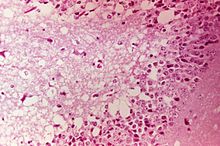Venezuelan equine encephalomyelitis
| Classification according to ICD-10 | |
|---|---|
| A92.2 | Venezuelan horse fever |
| ICD-10 online (WHO version 2019) | |
The Venezuelan equine encephalomyelitis (Engl. Venezuelan Equine Encephalitis , VEE) is a fatal viral disease of horses that like all Pferdeenzephalomyeliten notifiable animal diseases belongs. It can also be transmitted to humans ( zoonosis ) and can rarely cause a fatal disease.
Pathogen
| Venezuelan Equine Encephalitis Virus | ||||||||||||||||||||
|---|---|---|---|---|---|---|---|---|---|---|---|---|---|---|---|---|---|---|---|---|
| Systematics | ||||||||||||||||||||
|
||||||||||||||||||||
| Taxonomic characteristics | ||||||||||||||||||||
|
||||||||||||||||||||
| Scientific name | ||||||||||||||||||||
| Venezuelan Equine Encephalitis Virus | ||||||||||||||||||||
| Short name | ||||||||||||||||||||
| VEEV | ||||||||||||||||||||
| Left | ||||||||||||||||||||
|
The causative agent of the disease are viruses of the species Venezuelan Equine Encephalitis Virus (alias Venezuelan Equine Encephalomyelitis Virus , VEEV) from the genus Alphavirus of the Togaviridae family . This species, together with close relatives, forms a special group within this genus (VEEV group, English V enezuelan e quine e ncephalitis v irus complex ), to which u. a. also include the Rio Negro virus , Mucambo virus , Paramana virus, and Everglades virus . There are around six subtypes of VEEV, with only subtype 1 causing a serious disease and is therefore considered the actual pathogen. The animal disease occurs in South and Central America.
As the main vector act mosquitoes Culex tarsalis and Culex pipiens , it is also a contact infection with saliva of sick animals possible. Wild birds and rodents serve as virus reservoirs. Like pets, they are generally susceptible to the virus, but develop no or only mild symptoms.
clinic
The incubation period is 1 to 7 days. The disease is relatively unspecific. The virus is less neurotrophic than the other equine encephalomyelitis viruses. It often causes damage to blood vessels and can affect many organs. Clinically, fever , fatigue , reluctance to eat and, depending on the organ involvement, other symptoms occur.
The mortality in horses can be up to 80%, death usually occurs within 2-7 days.
As a rule, only mild clinical symptoms occur in humans, and the infection can be fatal in 1% of cases.
Combat
There is no effective therapy .
Web links
Individual evidence
- ↑ ICTV Master Species List 2018b.v2 . MSL # 34, March 2019
- ↑ a b c d ICTV: ICTV Master Species List 2019.v1 , New MSL including all taxa updates since the 2018b release, March 2020 (MSL # 35)
